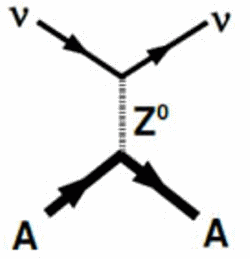A variety of applications exist for Spherical Proportional Counters (SPCs), making them an interesting technology, and useful in multiple fields. An application of great significance for this type of detector is its use in the detection of Coherent Neutrino-Nucleus Scattering, an interaction occurring on the whole nucleus, involving subkeV energy deposition. These detectors could be used to search for this interaction at nuclear reactors, or to detect neutrinos from supernovae.
Coherent Neutrino Nucleus Scattering (CNNS)
In this process, a neutrino collides with a nucleus via the exchange of a Z boson, causing the nucleus to recoil; the neutrino scatters coherently off of the entire nucleus of the atom at neutrino energies up to 50 MeV. Cross sections for this interaction are large – on the order of 10-39 cm2 – however, recoil energies are very small, typically less than 1 keV for MeV reactor neutrinos. As most current detectors operate above the 1 keV level, obtaining sensitivities low enough to detect CNNS has been very difficult.

Detecting supernovae neutrinos through CNNS would bring new information on neutrino properties and SN explosion process. As a star collapses, approximately 99% of the gravitational energy released goes into all flavours of neutrinos that have energies on the order of MeV. One idea is to have a network of SPC detectors worldwide, as they could be robust and low cost. While a few supernovae occur in our galaxy ever century, the last observed was over 30 years ago. Therefore, technology such as this would be of great importance in this field.
A SPC detector could also be used to measure CNNS at a nuclear reactor. Using a search window of 60-260 eV, approximately 20 events per day could be expected from a 1 m sphere filled with Argon gas at a pressure of 1 atmosphere, if the detector were positioned 10 m away from a 0.7 GWt nuclear reactor. This power level is well within the range of most medium size nuclear power plants.
Possible research applications include searches for non-standard interactions of neutrinos, measurement of neutrino magnetic moments, and neutron form factors. Spherical gas detectors are particularly useful for this research due to their low energy threshold.
Neutrinoless double-beta decay
The good energy resolution of SPCs make them a suitable technology in the search for neutrinoless double-beta decay. This type of decay, if observed, would imply that neutrinos are their own anti-particle (so-called Majorana neutrinos). The existence of Majorana neutrinos could help explain the asymmetry between the amount of matter and anti-matter in the Universe, as well as provide a mechanism to explain why neutrinos are so much lighter than other particles.
In neutrinoless double-beta decay, a nucleus would decay and emit two electrons. A high pressure gas deployed in an SPC would be ionized by those two electrons, and the resulting ionization charge could be determined to the accuracy required to identify the decay.
